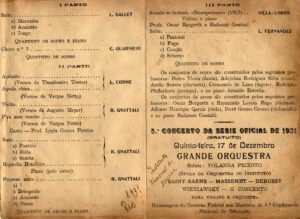- Composed the year before, Radamés premieres his Brazilian Rhapsody for piano, one of his first major works.
Diário de Notícias (RJ) 29.03.1931
- The Sala Beethoven, in Porto Alegre, holds the Brazilian Night event, featuring works by composers Radamés Gnattali and Luiz Cosme.
- Under the guidance of his former teacher, Guilherme Fontainha, Radamés moved to Rio de Janeiro to prepare for a competitive examination for the position of professor at the National Institute of Music, to be held in a few months[1].
- Radamés participates, in Rio de Janeiro, in the program of the Fourth Official Concert of the National Music Institute, in 1931, together with Luciano Gallet, Villa-Lobos, Lorenzo Fernandes, Luiz Cosme and Camargo Guarnieri.
 4th Concert of the 1931 Official Series – National Institute of Music. (17.12.1931)
4th Concert of the 1931 Official Series – National Institute of Music. (17.12.1931)
Correio da Manhã (RJ) (column Correio Musical) (12.12.1931)
- The instrumentalist, composer and conductor Nelson de Macedo, to whom Radamés dedicates the Divertimento a três para violino, viola e violoncelo, in 1983.
- Singer and composer João Gilberto (João Gilberto do Prado Pereira de Oliveira, 1931-2019) is born in Juazeiro, Bahia. From his recording of the samba Chega de Saudadesamba, by Tom Jobim and Vinícius de Moraes, in 1959, historians and scholars of Brazilian popular music consider it the founder of a new type of samba, which would establish and consolidate itself, throughout the 1960s, as bossa nova [2].
- Radamés composes:
-
For my ranch,
for singing and piano –
verses by Vargas Netto (Work cited in the press, the score is not in the author’s archive). - Little Suite, for 2 violins, viola, cello and piano
- Ponteio, Roda and Baile, for piano – with dedication to Vera, his fiancée.
Three poems by Augusto Meyer, for singing and
piano
(I.Guitar; II. Prayer of the Cattle Star; III. Bagpipe – the latter, finished in 1935). Dedicated to the baritone Adacto Filho.
-
III. Ball
Radamés Gnattali, by Olinda Alessandrini FUNPROARTE – s/nº (POA, n/a)
- Villa-Lobos gathers representatives from various social classes in São Paulo and organizes an Orpheonic Concentration called Exortação Cívica (Civic Exhortation), with the participation of about 12 thousand voices
- The samba Se você jurar (If you swear), by Ismael Silva, Nilton Bastos, and Francisco Alves, recorded by Francisco Alves and Mário Reis, outlines a new, less amaxixada samba beat that will become the classic standard of samba in Rio de Janeiro to this day.
- On October 12, the statue of Christ the Redeemer is inaugurated atop Corcovado Mountain in Rio de Janeiro.


